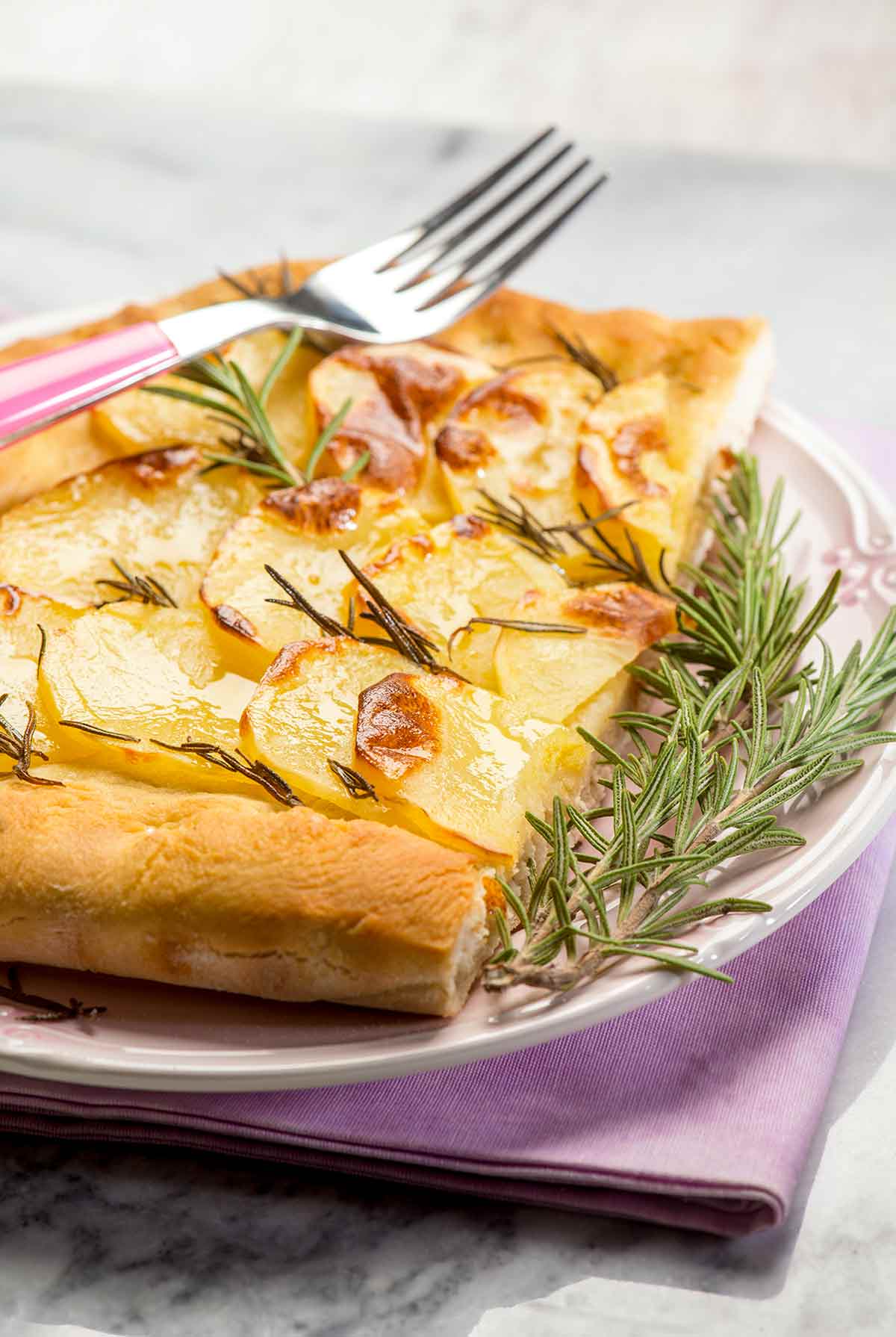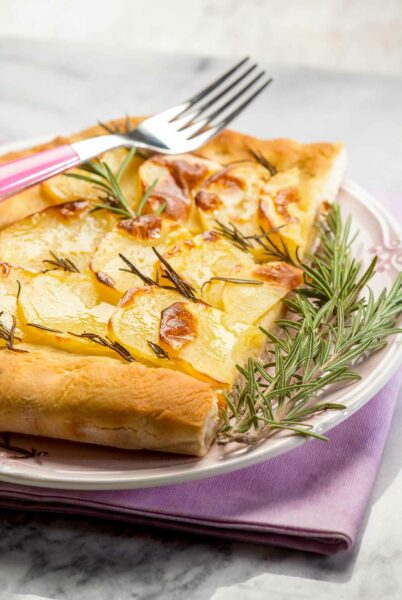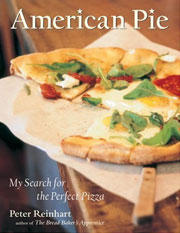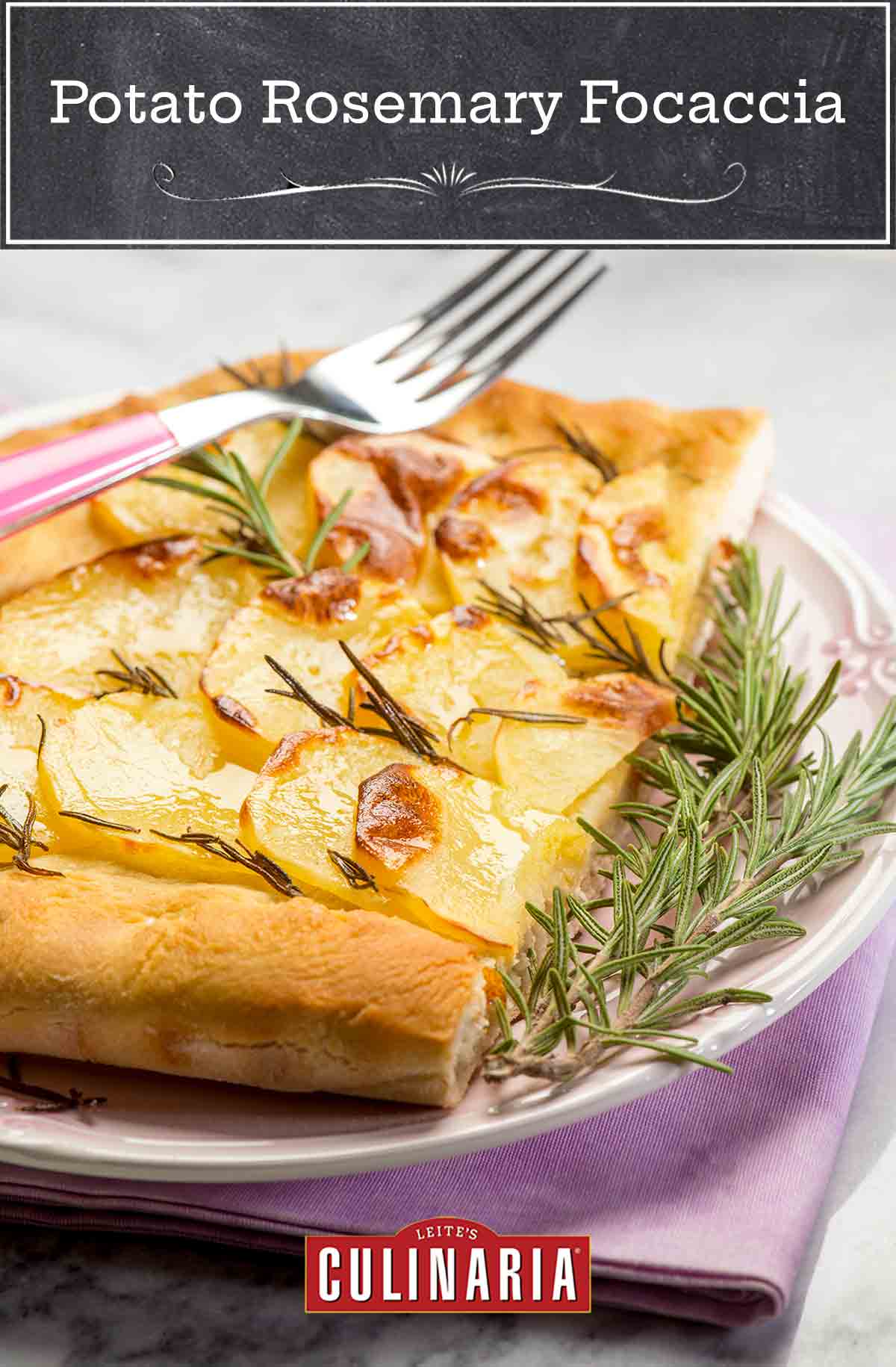
This focaccia variation, which goes under the name focaccia con patate e rosmarino in Tuscany and “potato pizza” in New York City, is beginning to emerge as the most popular topping among the new generation of focaccia fanciers. It is their benchmark in much the same way that the pizza Margherita is the benchmark for pizza and the baguette is for bread. When you make it, you’ll understand why. Like many of the dough recipes in this book, it utilizes a delayed-fermentation technique, a method so perfectly suited to focaccia that I now use this recipe in place of most of the previous focaccia recipes that I’ve learned or developed.–Peter Reinhart
WHAT IS FOCACCIA?
Like a lot of the best bread in the world, focaccia is Italian. Flatter than a loaf of bread, focaccia is pretty similar to a pizza crust in texture. The most striking feature, however, is all those dimples on the surface. They’re used to reduce air in the dough and to keep it from rising too quickly, keeping it flat and maintaining a lightweight texture. Those adorable dimples are also perfect to envelop whatever you choose to sprinkle in there–olive oil, sea salt, olives, sun-dried tomatoes, or herbs.

Potato Rosemary Focaccia
Ingredients
For the dough
- 5 3/4 cups unbleached bread flour
- 2 teaspoons table salt, or 3 1/2 teaspoons kosher salt
- 2 1/2 teaspoons instant yeast
- 2 1/2 cups ice-cold water, (40°F or 5°C)
- 1/4 cup olive oil
For the herb oil
- 2 cups olive oil
- 2 tablespoons dried basil
- 2 tablespoons dried parsley
- 1 tablespoon dried oregano
- 1 tablespoon rosemary leaves
- 1 teaspoon dried thyme
- 2 tablespoons granulated garlic powder, or 10 cloves fresh garlic, pressed and lightly sauteed in 1/2 cup of the olive oil, above
- 1 tablespoon kosher salt, or coarse sea salt
- 1/4 teaspoon freshly ground black pepper
- 1 teaspoon chile flakes, (optional)
- 1 teaspoon sweet or hot paprika, (optional)
For the focaccia
- 1/4 cup plus 2 tablespoons olive oil
- 1 1/2 pounds new potatoes, or Yukon Gold potatoes, peeled if desired
- 1 large white or yellow onion, cut into thin strips (optional)
- Leaves from 1 rosemary sprig
- 1 cup Herb Oil
- 1/2 teaspoon each coarse sea salt or kosher salt and freshly ground black pepper, or to taste
Instructions
Make the dough
- With a large metal spoon, stir together the flour, salt, yeast, and water in a 4-quart bowl or the bowl of an until combined. If mixing with an electric mixer, fit it with the paddle attachment and mix on low speed for about 2 minutes, or until all the ingredients are hydrated and begin to form a wet ball of dough. Let the dough rest for 5 minutes.
- Switch to the dough hook, add the olive oil, and resume mixing on medium-low speed for 3 to 4 minutes, or until all of the oil is incorporated and the dough is sticky, supple, and smooth; it should clear the sides of the bowl and stick just a little to the bottom. If the dough seems like a batter and does not have sufficient structure to hold itself together, mix in more flour by the tablespoonful.
- Even though it is sticky, the dough should still pass the windowpane test. If mixing by hand, repeatedly dip one of your hands or the spoon into cold water and use it much like a dough hook, working the dough vigorously as you rotate the bowl with your other hand. As all the flour is incorporated and the dough becomes a wet ball, about 3 minutes, stop mixing and let the dough rest for 5 minutes.
- Then add the olive oil, dip your hand or spoon again in water, and continue to work the dough for another 3 to 4 minutes. The dough should be very sticky, but it should also have some texture and structure.
- Form the dough into a ball and place it in a bowl brushed with olive oil. Turn the dough to coat it with the oil, cover the bowl with plastic wrap, and immediately refrigerate it overnight. The next day the dough should have nearly doubled in size. Allow it to sit at room temperature for about 2 hours before making the focaccia.
Make the herb oil
- In a bowl, whisk together all the ingredients. Let sit at room temperature for 2 hours before using.
Make the focaccia
- Shape and dimple the dough in a 12 by 17-inch (30 by 43-cm) sheet pan using the 2 tablespoons olive oil for preparing the pan and the 1/4 cup olive oil for dimpling the dough. Let the dough rise at room temperature for 2 to 3 hours, or until it fills the pan.
- While the dough is rising in the pan, prepare the potatoes. If using new potatoes, place them in a saucepan with water to cover, bring to a boil, and boil for about 10 minutes, or until they can be easily pierced with a fork. Drain, let cool (or plunge them in cold water to speed the process), and cut into 1/4-inch-thick (6 mm) slices. If using regular-sized Yukon Gold potatoes, slice them paper-thin using a food processor, a mandoline, or a chef's knife. In a bowl, combine the sliced potatoes, onion, if using, and rosemary. Pour in the herb oil and toss gently to coat.
- Preheat the oven to 500°F (260°C). When the focaccia is fully risen and ready to bake, remove the potatoes from the oil, shaking off the excess oil, and spread the slices over the surface of the dough, either randomly or stacked like dominoes. If using Yukon Gold potatoes, you may need to overlap more tightly to fit on the dough. If using onions, scatter them over the potatoes. Place the sheet pan on the middle shelf of the oven, bake for 5 minutes, and then lower the temperature to 400°F (200°C). Bake for 15 minutes, then rotate the pan 180 degrees. Continue to bake for 20 to 25 minutes longer or until the dough and the potatoes are golden around the edges.
- Remove the finished focaccia from the oven and immediately transfer it to a cooling rack. Drizzle any oil remaining in the pan, as well as any remaining herb oil, to taste, over the potatoes. Season with salt and pepper, then let cool for at least 20 minutes before cutting and serving.

Explore More with AI
Nutrition
Nutrition information is automatically calculated, so should only be used as an approximation.
Recipe Testers’ Reviews
This potato rosemary focaccia is a bit time intensive but was the perfect remedy for a long weekend at home during the pandemic when I really wanted to try something new that would take a little extra time to complete. The finished focaccia was olive oily, crusty, chewy, and everything that I wanted from this bread. The potatoes were lovely on top with the herbs, but one the real star for me was the optional onions. I used a yellow onion cut into very thin strips that I sort of randomly scattered over and under the potatoes. The strips turned into brown crunchy deliciousness on the finished product so I would not call them optional.
We liked this so much that we ended up pairing it with some vegetables and eating it for dinner. The quality of the olive oil is critical in this recipe – we had a lovely, fruity one that enhanced every step of this focaccia. I let the bread rise in the fridge overnight for about 12 hours before moving on to the next step and that seemed right to me. We drizzled some of the remaining herb oil over the potatoes, as listed in the recipe, but my spouse also liked to dip bits of the focaccia in the remaining oil for an occasional punch of herby flavor.
This is one of the best and easiest focaccia recipes you will ever make. The crust was perfectly baked and had a nice crunch with a very tender interior and a perfect crumb.
The herbs and the potatoes make for a great topping, but this dough would lend itself to other toppings as well, such as caramelized onions, olives, sun-dried tomatoes, red and/or green bell peppers.
To add a bit more flavor, be sure to use the leftover herb oil as a dip for the focaccia. The dough will be quite sticky when you put it together and may not have enough structure to hold together.
As the recipe indicates, you can add more flour to get it to the point where it holds together and passes the windowpane test. The windowpane test is one of the best ways to tell if your dough has been sufficiently kneaded for gluten development and is ready to rise by pulling a small piece of dough into a square to form a translucent membrane without breaking apart.
In my “test” of this recipe, I ended up adding a little more than a half cup of flour. I think this would be unusual in most cases, but I was in Florida at the time and the humidity was quite high. Most likely my flour had a higher than normal moisture content due to the humid environment and this is something you will never know with flour and breadmaking until you actually work with the dough.
If you’re looking for a crispy-on-the-outside, pillowy-on-the-inside, delicious focaccia, this is the recipe. I can see myself going back to this dough recipe again and again. It was time-consuming, but not incredibly hands-on, and it had the most amazing texture.
I felt like the herb oil, however, was too full of dried herbs, it left the potatoes covered in a ton of dried herbs that didn’t add a lot of flavor to the dish. I think maybe straining it and then adding more fresh herbs with the rosemary would be nice. The one sprig of rosemary also didn’t add enough rosemary flavor, and I was expecting more based on the recipe name. The potatoes cooked beautifully, I used thin-sliced Yukon Golds, they turned out buttery and caramelized.
It seems that these days everyone has been captured by the magic of bread making. As I see friends and family revel in their feats of creating the perfect sourdough or french loaves at home, I can’t help but notice the lack of focaccia being made. This relatively hands-off potato rosemary recipe combines the allure of bread making with a touch of pizza making to create a truly crave-able treat.
Don’t let the total time fool you, every minute for this focaccia is absolutely worth it. The combination of the airy dough with the slightly spicy herb oil (I decided to opt-in to the chili flake and hot paprika additions to the oil) and crispy potatoes on top is absolute heaven. The thinness of the potatoes doesn’t add any heaviness to the bread itself but acts as a crispy element to break down the chewiness of the bread.
I also decided to add the onions into the potatoes while they marinated in the herb oil for a little sweetness. I didn’t want to include the onions on top of the focaccia (in fear of them burning) so while the focaccia was baking, I cooked the onions in the herb oil it was sitting in until the onions were soft and the fresh rosemary was nice and crispy. I ate it with the fresh focaccia to create a new texture and add a little more herbiness to the focaccia.
If you’re looking for a great side dish to bring to a potluck or just something to snack on for a light lunch, do not skip on this recipe.












I posted a pic on the What’s for Dinner FB page. We love it but …
– the dough was too dry resulting in a pretty dense loaf without the characteristic holes
– 8 potatoes?! – are they meant to be layered in 3-4 layers?
Don’t get me wrong – still yum. But I layered thinly sliced Yukon Gold & sweet potato and a sweet onion also mandolined. I had 4 potatoes and enough leftover for a small Torta Español!
I will try adding more water and maybe up the portion of white whole wheat (I used 3/4 C here) – and I’d use only 2 potatoes.
Jacqueline, sounds like you freelanced a bit here. Whole-wheat flour takes longer to absorb liquid than all-purpose flour and will require more. King Arthur flour says, “The same amount of water used in both an all-purpose flour and whole wheat flour bread recipe will yield whole wheat dough that’s stiffer than AP dough.”
Also did you weigh the potatoes? I believe Peter is referring to new potatoes that are 2 or so inches in diameter.
I almost always do. But I really didn’t think 3/4 C would make that much difference with the 5 C of bread flour? “Longer to absorb”? Does that mean using same ratio if I let it sit / rise longer (as opposed to adding more liquid?) it would be okay? I actually got huge lovely rise and left in fridge overnight etc.
“1 1/2 lbs of Yukon gold potatoes” so I didn’t weigh, even though I have a scale. It was not a disaster by any means…I think if the flour had been in weights rather than cups, I would have done.
Baking is more exact..I know, but somehow I think of focaccia as different. Anyway, have a peek at the FB page, pretty good for a first shot. ?
Jacqueline, I misread your comment. You’re right–3/4 cup wouldn’t make a difference. Hmmmm, I’m a bit flummoxed then. And the Facebook picture looks great! It looked so great, I had to post it here, too. Hope you don’t mind.
I prepared the dough (in the fridge) and oil for tonight’s dinner and just found out our plans changed. Can I use the dough tomorrow?
Angela, it should be ok, as long as you keep it refrigerated.
I was drawn to this recipe for some reason. I just had to make it. I was a little concerned about how it would go over, but my fears were unfounded. It tasted wonderful with a crispy crust and soft filling. I will make this again but, with perhaps a little less oil. Thank you.
You’re welcome. And thanks in return for taking the time to let us know about your experience. Feedback from readers means a lot to us. So glad you enjoyed the focaccia enough to want to make it again.